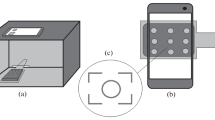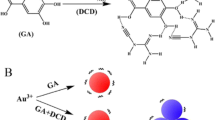Summary
A new sensitive and selective spot test for cerium(IV) using the triphenylmethane dyes, Erioglaucine A, Eriogreen B, Xylenecyanol FF, Setoglaucine O, and Setocyanine Supra, respectively, is described. The method consists of adding one drop of the dye solution (0.1%) to a drop of cerium(IV) solution, and then treating the mixture with sufficient amount of sulfuric, perchloric, or phosphoric acid to maintain the acidity at 6 to 9M. The colors produced with these dyes are: Erioglaucine A: orange, Eriogreen B: bright red, Xylenecyanol FF: orange yellow, Setoglaucine O: bright orange, and Setocyanine Supra: pink. The identification limit is 1 μg in 1.5 ml, and the dilution limit is 1∶1.5 · 106 in all these cases. Many cations and anions do not interfere in the test, whereas reducing agents like Fe(II), Mo(V), U(IV), and hydroquinone, fluoride and EDTA interfere.
Zusammenfassung
Eine neue empfindliche und selektive Tüpfelnachweisreaktion für Cer(IV) mit den Triphenylmethanfarbstoffen Erioglaucin A (I), Eriogrün B (II), Xylolcyanol FF (III), Setoglaucin O (IV) bzw. Setocyanin Supra (V) wurde beschrieben. Man gibt einen Tropfen 0,1%ige Farbstofflösung zu einem Tropfen Cer(IV)-Lösung und behandelt die Mischung mit Schwefelsäure, Perchlorsäure oder Phosphorsäure, um 6 -bis 9-m Acidität zu erreichen. Die mit den genannten Farbstoffen erzielten Farbreaktionen sind: mit I orange, mit II leuchtend rot, mit IV leuchtend orange, mit III orange-gelb, mit V rosa. Die Erfassungsgrenze beträgt 1μg/1,5 ml, die Grenzkonzentrationen in jedem Fall 1∶1,5 · 106. Viele Kationen und Anionen stören nicht, aber Reduktionsmittel wie Fe(II), Mo(V), U(IV), Hydrochinon sowie Fluorid und ÄDTA stören.
Similar content being viewed by others
References
J. L. Garnett andL. C. Lock, Analyt. Chim. Acta17, 351 (1957).
L. Sommer, Z. analyt. Chem.187, 263 (1962).
P. L. Sarma, Analyt. Chim. Acta27, 370 (1962).
V. P. Rao andD. Satyanarayana, Z. analyt. Chem.197, 409 (1963).
A. K. Batalin, Izv. Vyssh. Ucheb, Zavedemir, Khim. i. Khim. Tekhnol5, 845 (1962).
N.-K. Shen andH. H. Ching, Acta Chim. Sinica30, 218 (1964).
G. Somidevamma andM. S. Sarma, Chemist-Analyst56, 92 (1967).
F. M. Shemyakin, Zavodskaya Lab.3, 1090 (1934).
P. Wenger, R. Duckert, andC. P. Blancpain, Helv. Chim. Acta20, 1427 (1937).
L. Fernandes, Gazz. chim. Ital.55, 616 (1925).
F. M. Shemyakin andT. V. Vasedchenko, J. Gen. Chem. (U. S. S. R.)5, 667 (1935).
E. Herzfeld, Z. analyt. Chem.115, 421 (1939).
R. Lang, Mikrochim. Acta3, 116 (1938).
K. Haushofer, Jahresber. Min.1, 180 (1885).
F. M. Shemyakin andA. N. Belokon, C. r. acad. sci. (U. S. S. R.)18, 275 (1938).
F. Wirth, Chem.-Ztg.37, 773 (1913).
R. G. Harry andE. A. Rudge, J. Soc. Chem. Ind.51, 64 (1932).
G. Beck, Pharm. Acta Helv.13, 304 (1938).
G. Charlot, Bull. soc. chim.6, 1126 (1939).
I. M. Korenman, Z. analyt. Chem.93, 438 (1933).
J. F. Miller, Ind. Eng. Chem., Analyt. Ed.9, 181 (1937).
F. M. Shemyakin, V. A. Volkova, andA. S. Bozhko, J. Gen. Chem. (U. S. S. R.)8, 452 (1938).
E. Herzfeld, Z. analyt. Chem.115, 421 (1939).
L. Kul'berg, Mikrochem.21, 35 (1936).
R. A. Reed, Analyst63, 338 (1938).
F. M. Sheyakin, C. r. acad. sci. (U. S. S. R.)14, 115 (1937).
A. S. Komarovskii andI. M. Korenman, Z. analyt. Chem.94, 247 (1933).
J. Lucas andA. Jilek, Chem. listy23, 417 (1929).
G. Mannelli, Ann. chim. applicata32, 356 (1942).
J. H. Yoe andL. G. Overholzer, Ind. Eng. Chem., Analyt. Ed.14, 435 (1942).
G. Charlot, Analyt. Chim. Acta1, 309 (1947).
T. J. Hardwick andE. Robertson, Canad. J. Chem.29, 828 (1951).
Author information
Authors and Affiliations
Rights and permissions
About this article
Cite this article
Venkateswara Rao, N., Eswara Dutt, V.V.S. A new spot test for cerium(IV) using triphenylmethane dyes. Mikrochim Acta 58, 292–296 (1970). https://doi.org/10.1007/BF01221606
Received:
Issue Date:
DOI: https://doi.org/10.1007/BF01221606




